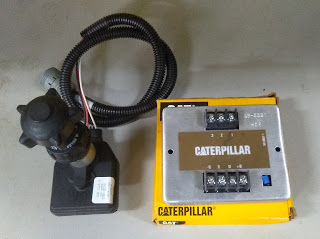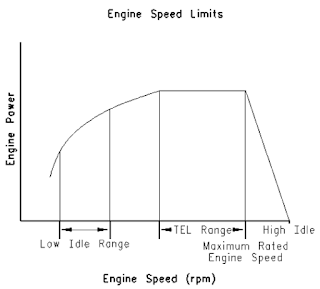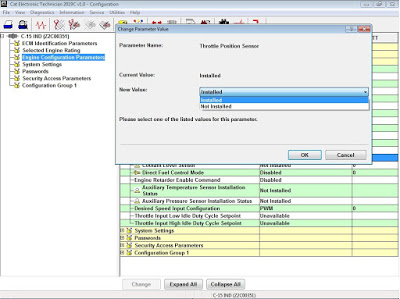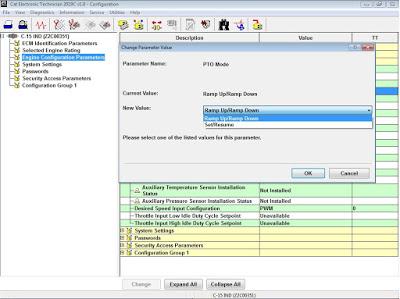
Desired Speed Control
Top Engine Limit (TEL)
“TEL” is a customer programmable parameter that defines the maximum allowable engine speed for maximum power (Software Dependent). “TEL” can be programmed up to the maximum rated engine speed. “TEL” is defined along the engine’s lug curve.
Low Idle Speed
“Low Idle Speed” is the minimum allowable operating speed for the engine. This parameter can be programmed between 600 and 1400 rpm
High Idle Speed
“High Idle Speed” is the maximum no-load engine speed when the throttle or the PTO switch is in the maximum position (Software Dependent). “High Idle Speed” cannot be programmed lower than “TEL”. Read More: Setting LOW IDLE Speed and HIGH IDLE Speed on Caterpillar ET Software
Engine Acceleration Rate
“Engine Acceleration Rate” determines the rate of change of the engine speed (50 to 1000 rpm/s). This parameter may also help reduce smoke when you start the engine.
Intermediate Engine Speed
“Intermediate Engine Speed” defines the speed for the engine when the intermediate engine speed switch is activated. This parameter can be programmed to any engine speed between “Low Idle Speed” and “TEL”. Engine speed will increase or engine speed will decrease at the rate that is defined by the programmed value for “Engine Acceleration Rate”.
Desired Speed Input Configuration
Program the “Desired Speed Input Configuration” to match the type of input signal for desired engine speed. The desired speed input defines the type of signal that is used for the throttle control. A numeric value is used by Cat ET to set the input for the ECM. The following inputs are available:
0-5 VDC Input
4-20 mA Input
CAN Input – if the throttle signal is transmitted over the CAN J1939 data link.
PWM – if a throttle position sensor or direct fuel control is used (as Figure 1.1 above).
Throttle Input Low Idle Duty Cycle Setpoint
This parameter can be used to set the duty cycle for low idle. If the throttle position sensor that is used will not reach 10 % duty cycle, the duty cycle can be increased up to a maximum of 40 %.
Throttle Input High Idle Duty Cycle Setpoint
This parameter can be used to set the duty cycle for high idle. If the throttle position sensor that is used will not reach 90 % duty cycle, the duty cycle can be decreased to a minimum of 50 %.
Throttle Position Sensor
Program the “Throttle Position Sensor” to “Installed” if a throttle position sensor is used for desired speed control. Otherwise program this parameter to “Not Installed”.
PTO Mode
“PTO Mode” allows the ECM to be programmed to either one of the two PTO configurations that are available.
Ramp Up/Ramp Down – when “PTO Mode” is programmed to “Ramp Up/Ramp Down”, the ECM allows PTO operation with traditional features.
Set/Resume – when “PTO Mode” is programmed to “Set/Resume”, the ECM allows PTO operation with enhanced features.
#Additional Information:
-PTO Enable Switch – J1/P1:56
-PTO Rump Up/Set Switch – J1/P1:58
-PTO Rump Down/Resume Switch – J1/P1:60
-Intermediate Engine Speed Switch – J1/P1:45
-Throttle Position 1 (PWM) – J1/P1:66
-Throttle Position 2 (PWM) – J1/P1:68





